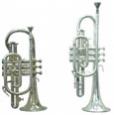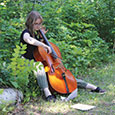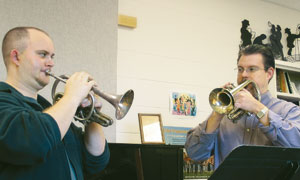
When I was young, a friend in my seventh-grade beginning band class played a strange looking instrument that belonged to his grandfather. It was all wound up with tubes and much shorter than my trumpet. Its mouthpiece shank was too small to fit my trumpet, and mine too large to fit his instrument. He said it was a cornet but that it was just the same as a trumpet; it played the same notes, used the same fingerings, and was in the same key of B flat; he could also read from the same music.
When some of the other students teased him about the instrument, my friend eventually switched to a trumpet. He needed to fit in rather than be different, and this, in essence, is what has happened to the cornet in American band programs. Every band director across the United States has come across an old cornet, bent, broken, and long forgotten, packed away in a smelly case in the back of the band room. He lends it out, only if he has to, and probably feels bad in doing so.
Part of a director’s job is to recommend good-quality affordable instruments for students, but it is also important to keep up with current trends by using instruments and brands that other successful directors and programs use. If this is the case, I often wonder what has happened to cornets. Some band directors think of it as just an outdated predecessor of the modern trumpet. However, I believe that the correct use and perhaps rediscovery of the cornet in band literature – as it was originally intended – is a new trend for band programs today.
Brass Tradition
High school band programs today represent the evolution of military band and brass band tradition. Both of these traditions historically used the cornet and continue to embrace the instrument in their performances today. Further, the top concert bands of the Armed Forces, such as The President’s Own Marine Band the The Commandant’s Navy Band, use cornets; these ensembles have become models of musical and professional achievement among high school and university band programs.
The popularity of the cornet flourished with the growth of town bands, the rise of touring ensembles like John Philip Sousa’s, and the virtuosity of Herbert L. Clarke, a solo cornetist with the Marine Band under the baton of John Philip Sousa. By the mid-19th century town bands even became known as cornet bands. Band literature included mostly marches and arrangements of popular song and folk themes, scored with cornet parts; and traditional masterworks, whether original or transcribed, were intended specifically for cornet alone or a combination of cornet and trumpet.
Progressive repertoire for band programs today, however, favors the trumpet because commercially geared composers write for the instruments that are in use today. As a result concert band repertoire, unfortunately, is losing a tonal and textural effect because composers no longer write for cornet and by the same extent flugel horn as well.
British Influence
Although band tradition in the United States has direct ties to the United Kingdom, there are differences in the sound and interpretation of the military and brass bands of these two countries. In the United States trumpet teaching and performance style favors orchestral and commercial genres as well as jazz, along with exclusive use of the trumpet. This has affected the sound and style of most band music. British military bands have always used cornets on cornet parts and trumpets (usually there are only two and sometimes none) on trumpet parts.
Brass players in military bands are usually former brass band players, which gives military bands in the United Kingdom their distinct quality of sound. Woodwinds perform in the light English style, often lighter than military bands in the U.S., and play very short staccatos when indicated.
Brass play like a small brass band within the military band, using a melodic style with traditional English cornet mouthpieces. The approach is always relaxed and unforced, unlike trumpets that have a large volume of sound and brilliant tone.
Literature
As a general rule, all English band music, including marches, should be played with cornets on the cornet parts. In addition to English band music, band compositions or arrangements that are traditional in nature – composed or arranged during the period when cornets were common in the United States – should also honor the cornet-trumpet distribution.
From a practical point of view, this means publications up to around 1945, including Percy Grainger’s pieces, which fall into this category as do most traditional marches and many of the older transcriptions. The later marches by Clifton Williams are intended for trumpet.
Many prominent composers and arrangers of band wrote for cornet and many times combinations of cornet and trumpet for textural effect. Here is a brief but important list of composers and their pieces that use cornet:
Aaron Copland
El Salon Mexico (tr. Hindsley)
Emblems
Sir Edward Elgar
As Torrents in Summer (tr. Davis)
Enigma Variations (tr. Slocum)
Pomp and Circumstance March IV
(tr. Reed)
Severn Suite (tr. Reed)
Sussum Corda (tr. Houseknecht)
Vittorio Gianinni
Fantasia for Band
Symphony #3
Variations and Fugue
Percy Grainger
Blithe Bells
Children’s March: “Over the Hills
and Far Away”
Colonial Song
Gumsucker’s March
Handel in the Strand
The Immovable Do (1940)
Irish Tune from County Derry
Lincolnshire Posy
Mock Morris
Molly on the Shore
Scotch Strathspey and Reel
(tr. by Leroy Osmon)
Ye Banks and Braes O’ Bonnie Doon
Clare Grundman
A Copland Portrait
Gustav Holst
First Suite in E flat (1909)
Hammersmith: Prelude and
Scherzo (1930)
Second Suite in F (1911)
Vaclav Nelhýbel
Symphonic Movement
Three Revolutionary Marches
Trittico
Vincent Persichetti
Pageant (1953)
Psalm for Band (1953)
Serenade for Band (1960)
Symphony #6
Alfred Reed
Fifth Suite for Band
A Festival Prelude (1962)
A Festive Overture (1963)
Othello
Russian Christmas Music (1944)
William Schuman
New England Tryptich
“Be Glad Then America”
“When Jesus Wept”
“Chester”
Gunther Schuller
Meditation
Symphony for Brass and Percussion
Song and Dance
Study in Textures
Symphony #3, “In Praise of Winds”
Ralph Vaughn Williams
English Folk Song Suite (1924)
Flourish for Wind Band (1939)
Norfolk Rhapsody
(tr. Robert O’Brien) (1905)
Overture to The Wasps
(tr. Frank Hudson) (1909)
Rhosymedre (tr. by Beeler)
Sea Songs (1925)
Toccata marziale (1924)
Current Trends
The growing interest in early music performance groups, orchestras, and soloists should include early wind ensembles, with everything from early wind chamber music to military bands, brass bands, and town bands. The cornet is part of this performance practice.
Interest in using traditional cornets in these groups began in the U.S. in the late 1970s and early 80s, but it took 30 or more years for the instrument to gain acceptance. During this time the rise of brass bands in America and their participation in the North American Brass Band Association and its competitions has been similar to brass band competitions in England.
NABBA provides a network in which these groups exist, operate, and communicate, with brass band enthusiasts giving new attention to recapturing the traditions and origins of brass band playing and equipment. This has led to more interest in the cornet, especially from instrument manufacturers. This will carry over to concert bands at the high school, middle school, and elementary levels in the form of good music education. Further, the cornet will preserve band history and improve the musical experience of all players, conductors, and audiences in the future.
Cornet vs. Trumpet–A Brief History
With the creation of the piston valve by Etienne-François Périnet in France (1829-39), the cornet became popular as an instrument suitable for soloistic feats that were previously reserved for fully chromatic instruments. New-found chromaticism, agility, and a pleasing tone made the cornet highly acceptable.
The idea for a cornet may have come from a German post horn fitted with valves made by Heinrich Stölzel, and Parisian instrument maker Jean Hilaire Asté (known as Halary), applied valves like that of Stölzel’s to a postal horn used by the mailcoach drivers (Methode théorique & practique de cornet à piston ou cylinders by François Georges Auguste Dauverné). As a result the cornet’s tubing is more conical than a trumpet, which is cylindrical.
At about the same time in 1815, the natural trumpet, which had cylindrical tubing and no valves, was also fitted with valves with the idea of getting the trumpet as well as the horn and other brass to become fully chromatic. Thus, modern versions of the trumpet and cornet are different branches of the same tree. They were treated as independent instruments in the middle of the 19th century, even though trumpet players played cornet and vise-versa.
By the mid 1800s instructors taught students to play both the trumpet and cornet in specialized, separate ways. The best example of this was the introduction of the Cornet à Pistons in Berlioz’s Symphonie Fantastic (1830), whose score indicated natural trumpet and Cornet à Pistons side by side; the differences in tone quality produced a great and extremely interesting effect in the music.
Arban’s Influence
Professors at the Paris Conservatory offered independent courses for both the natural trumpet and cornet; and Jean Baptist Laurent Arban, who was professor of cornet at the Paris Conservatory, wrote his widely known Grand Methode pour Cornet à Pistons ou Saxhorns as a cornet method. It is widely used today as a trumpet method in America and has been edited several times by leading American trumpeters to the point that the original versions are rarely used. F.G.A. Dauverné, who was a trumpet professor at the Conservatory, also produced his own Methode pour Trompette. Arban, himself a student of Dauverné, later became a colleague and taught alongside his mentor.
Because of the agility and beauty of the cornet’s tone, it became popular as a solo instrument; any technical limitations were strictly those of the player. Arban makes it wonderfully clear how virtuosic the cornet could be in each of his 16 Characteristic Studies and 12 Solo Themes and Variations.
The trumpet, even though fitted with valves, was important to the orchestra because of its brilliant tone and ability to project. In England in the late 19th century and into the middle of the 20th century, it became common for cornetists of that time to play soloistically with vibrato and romantic nuance while the trumpet retained its noble character, reminiscent of grand fanfare-style works with a straight tone.
As time continued contemporary compositions that had a romantic or sentimental style of cornet playing did not complement the abstract sounds composers were creating, sometimes in rebuttal of the older romantic style. A player might sound old-fashioned playing with vibrato and rubato on modern compositions, even on trumpet.
The romantic style of playing fell out of fashion and the cornet declined in popularity as part of this shift in style. By the 1950s and 60s the decline was complete as modern sounds increased and the popularity of jazz and big bands accelerated a preference among audiences for the brilliant, big sound of the trumpet.
Only now with a fresh outlook can band directors realize it is possible to accept and perform all styles of music with the correct instruments and instrumentation, regardless of the era. In fact, people are now rediscovering and enjoying the lost nuance that these instruments are helping to return to the music.
Cornet Equipment
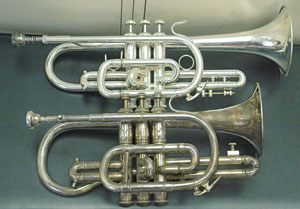 As the trend toward the trumpet continued, American cornet design became increasingly more like the trumpet. For nearly 30 years, from 1940 to 1970, the cornet’s tubing wrap narrowed vertically, appearing elongated overall, and the bell flare and throat started to resemble the bell of a trumpet. The preference for a brighter sound started as early as the 1920s, influenced by Louis Armstrong whose switch to trumpet no doubt contributed to the decreasing popularity of the cornet. With manufacturers changing the design for a brighter sound using a shallower-cupped mouthpiece on the cornet, many brass players wondered what the point was in making cornets.
As the trend toward the trumpet continued, American cornet design became increasingly more like the trumpet. For nearly 30 years, from 1940 to 1970, the cornet’s tubing wrap narrowed vertically, appearing elongated overall, and the bell flare and throat started to resemble the bell of a trumpet. The preference for a brighter sound started as early as the 1920s, influenced by Louis Armstrong whose switch to trumpet no doubt contributed to the decreasing popularity of the cornet. With manufacturers changing the design for a brighter sound using a shallower-cupped mouthpiece on the cornet, many brass players wondered what the point was in making cornets.
To facilitate the beauty of tone and agility capable of the cornet, band directors should use cornets made with an open wrap of tubing and a shepherd’s crook located at the back bend of tubing before reaching the bell.
When using cornets the most important issue to address is the mouthpiece, which has a slightly narrower rim with a much deeper cup than a trumpet mouthpiece; the result for the cornet is a mellow tone compared to the brilliant sound of a trumpet. Inadequate mouthpieces are trumpet mouthpieces in disguise made with a trumpet mouthpiece rim width and trumpet cup that is shallow compared to the cornet’s. These mouthpieces may resemble a cornet mouthpiece only because they require a smaller shank to fit the receiver of the cornet.
If you happen to have a set of trumpetlike cornets without such an open wrap and shepherd’s crook, I suggest you still use correct cornet mouthpieces because they will dramatically change the tone of the instruments. If you plan to purchase mouthpieces that will fit the instrument and play in tune, measure the diameter of the receiver of each instrument and the distance in to the receiver to the lead pipe.
Recommended Cornet
Mouthpieces and Instruments
Mouthpieces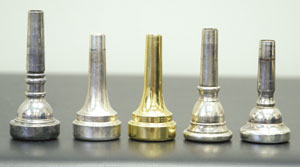
Denis Wick: 2, 3, 4, 5 (2b, 3b; the b cups are modern alternatives for trumpeters; the tone tends to be half-way between a trumpet and cornet); also the new Heritage Series
Schilke: 11E, 8E2
Lewington McCann: Phillip McCann
Yamaha: CR 11C4, CR 11E4, CR 13E4, CR14E, CR 16E
Sparx (GR): Model 2 – Diameter .670" (similar to Denis Wick 2B and Yamaha 16E); Model 3 – Diameter .660" (similar to DW3B); Model 4 – Diameter .650" (similar to DW4B)
Cornets
Schilke: Models XA1 and XA7
Yamaha: YCR-2330ll, YCR-8335
Besson: Model BE928
Smith-Watkins: Professional, Artiste, and Soloist models
Getzen: Custom Series, Eterna Series; 700, Capri, and 300/400 Series
Cornets in Beginning Band
I encourage directors to use the cornet as a starter instrument for beginning students for several practical reasons. The shorter cornet brings the center of gravity closer to the body. Young students’ shorter arms can hold the instrument better and avoid a drooping playing position. A cornet also helps young players develop a good embouchure and play with a better tone than they would on a trumpet.
On average student model cornets are priced slightly less than trumpets, which is of practical value to the parents of students starting out on the instrument. The small size of the cornet makes it easier to store in the band room and lighter in weight to carry around.
Some Final Thoughts
Cornets by nature are blending instruments compared to trumpets that project and cut through sound, so encourage your students to play out. Ultimately, cornets project best when players balance as a section, play in tune, and when they do not have to compete dynamically.
Think of the brass band model within the concert band. Trumpet students who switch to cornet during rehearsals will need time to adjust to the new mouthpiece. Encourage them to warm up first on the cornet and then switch to trumpet, this will expedite the adjustment period.
The beautiful cornet timbre is something to embrace, creating nuance and contrast in the texture of a concert band. It’s a quality I hope to continue hearing in many more school ensembles.
